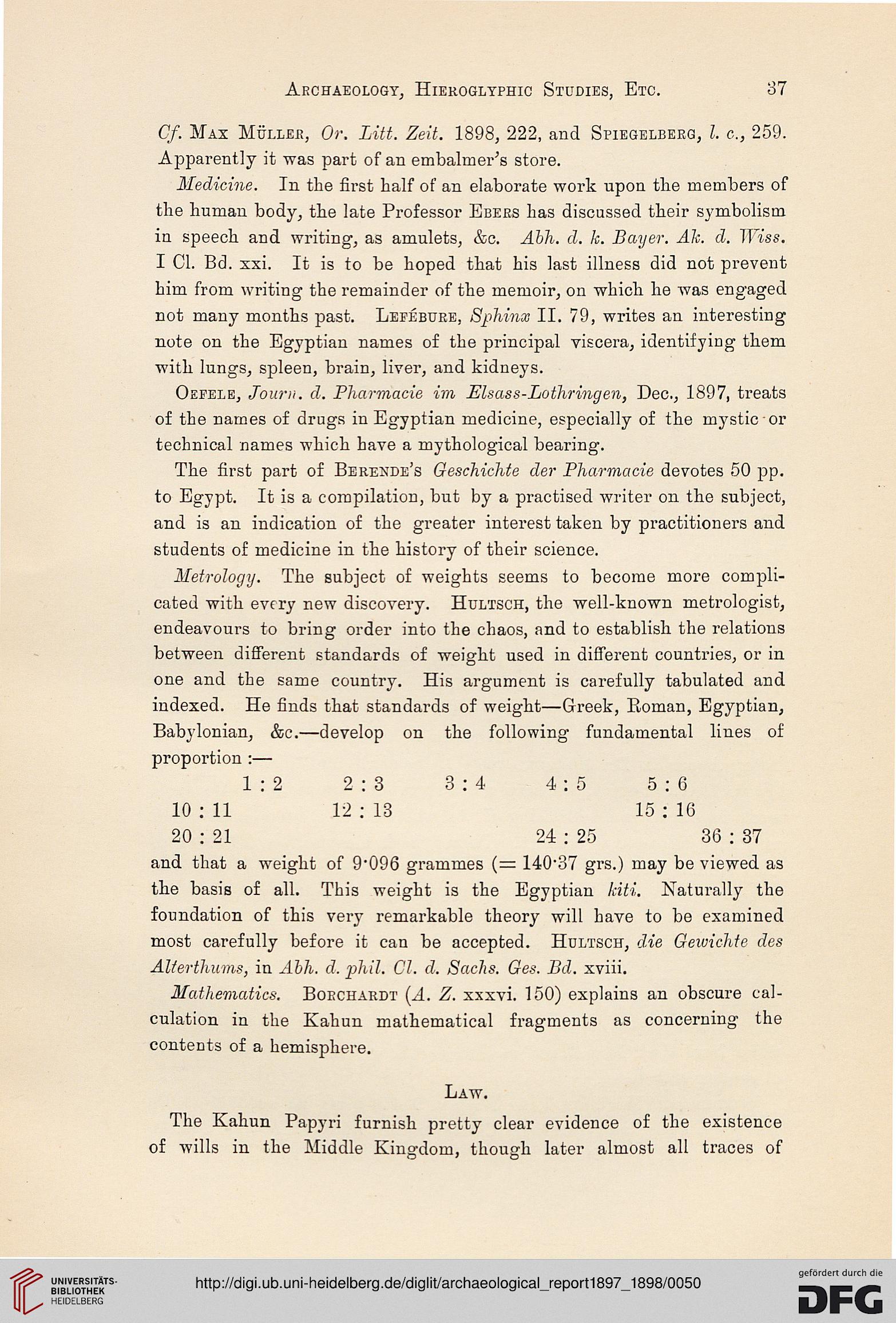Archaeology, Hieroglyphic Studies, Etc.
37
Gf. Max Muller, Or. Litt. Zeit. 1898, 222, and Spiegelberg, I. c, 259.
Apparently it was part of an embalmer's store.
Medicine. In the first half of an elaborate work upon the members of
the human body, the late Professor Ebers has discussed their symbolism
in speech and writing, as amulets, &c. Abh. d. k. Bayer. Ah. d. Wiss.
I CI. Bd. xxi. It is to be hoped that his last illness did not prevent
him from writing the remainder of the memoir, on which he was engaged
not many months past. Lefebure, Sphinx II. 79, writes an interesting
note on the Egyptian names of the principal viscera, identifying them
with lungs, spleen, brain, liver, and kidneys.
Oepele, Jouru. d. Pharmacie im Elsass-Lothringen, Dec, 1897, treats
of the names of drugs in Egyptian medicine, especially of the mystic-or
technical names which have a mythological bearing.
The first part of Berende's Geschichte der Pharmacie devotes 50 pp.
to Egypt. It is a compilation, but by a practised writer on the subject,
and is an indication of the greater interest taken by practitioners and
students of medicine in the history of their science.
Metrology. The subject of weights seems to become more compli-
cated with every new discovery. Hultsch, the well-known metrologist,
endeavours to bring order into the chaos, and to establish the relatious
between different standards of weight used in different countries, or in
one and the same country. His argument is carefully tabulated and
indexed. He finds that standards of weight—Greek, Eoman, Egyptian,
Babylonian, &c.—develop on the following fundamental lines of
proportion :—
1:2 2:3 3:4 4:5 5:6
10: 11 12: 13 15: 16
20 : 21 24 : 25 36 : 37
and that a weight of 9*096 grammes (= 140-37 grs.) may be viewed as
the basis of all. This weight is the Egyptian kiti. Naturally the
foundation of this very remarkable theory will have to be examined
most carefully before it can be accepted. Hultsch, die Gewichte des
Al/ertliums, in Abh. d. phil. CI. d. Sachs. Ges. Bd. xviii.
Mathematics. Borchardt (A. Z. xxxvi. 150) explains an obscure cal-
culation in the Kahun mathematical fragments as concerning the
contents of a hemisphere.
Law.
The Kahun Papyri furnish pretty clear evidence of the existence
of wills in the Middle Kingdom, though later almost all traces of
37
Gf. Max Muller, Or. Litt. Zeit. 1898, 222, and Spiegelberg, I. c, 259.
Apparently it was part of an embalmer's store.
Medicine. In the first half of an elaborate work upon the members of
the human body, the late Professor Ebers has discussed their symbolism
in speech and writing, as amulets, &c. Abh. d. k. Bayer. Ah. d. Wiss.
I CI. Bd. xxi. It is to be hoped that his last illness did not prevent
him from writing the remainder of the memoir, on which he was engaged
not many months past. Lefebure, Sphinx II. 79, writes an interesting
note on the Egyptian names of the principal viscera, identifying them
with lungs, spleen, brain, liver, and kidneys.
Oepele, Jouru. d. Pharmacie im Elsass-Lothringen, Dec, 1897, treats
of the names of drugs in Egyptian medicine, especially of the mystic-or
technical names which have a mythological bearing.
The first part of Berende's Geschichte der Pharmacie devotes 50 pp.
to Egypt. It is a compilation, but by a practised writer on the subject,
and is an indication of the greater interest taken by practitioners and
students of medicine in the history of their science.
Metrology. The subject of weights seems to become more compli-
cated with every new discovery. Hultsch, the well-known metrologist,
endeavours to bring order into the chaos, and to establish the relatious
between different standards of weight used in different countries, or in
one and the same country. His argument is carefully tabulated and
indexed. He finds that standards of weight—Greek, Eoman, Egyptian,
Babylonian, &c.—develop on the following fundamental lines of
proportion :—
1:2 2:3 3:4 4:5 5:6
10: 11 12: 13 15: 16
20 : 21 24 : 25 36 : 37
and that a weight of 9*096 grammes (= 140-37 grs.) may be viewed as
the basis of all. This weight is the Egyptian kiti. Naturally the
foundation of this very remarkable theory will have to be examined
most carefully before it can be accepted. Hultsch, die Gewichte des
Al/ertliums, in Abh. d. phil. CI. d. Sachs. Ges. Bd. xviii.
Mathematics. Borchardt (A. Z. xxxvi. 150) explains an obscure cal-
culation in the Kahun mathematical fragments as concerning the
contents of a hemisphere.
Law.
The Kahun Papyri furnish pretty clear evidence of the existence
of wills in the Middle Kingdom, though later almost all traces of





